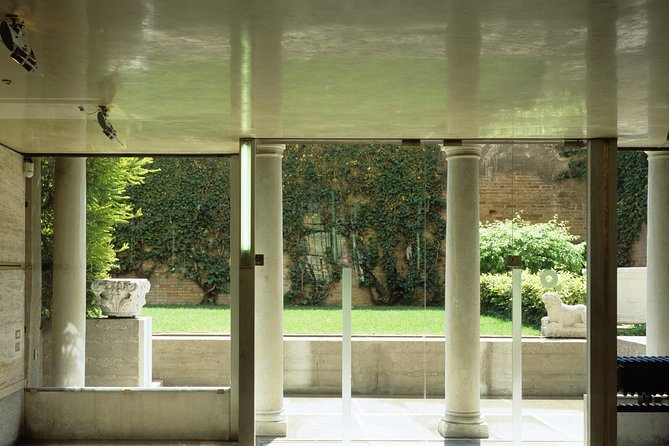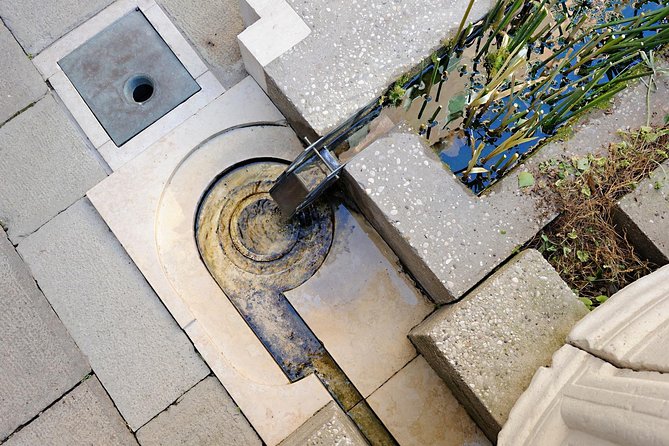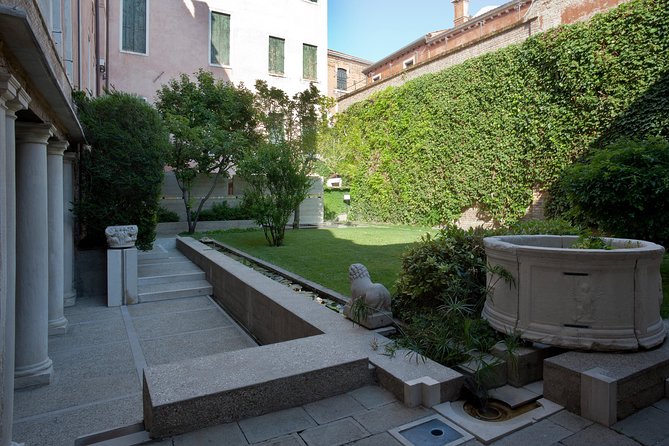Carlo Scarpa’s architectural legacy in Venice is undeniable. His innovative approach blended modernist design with the city’s historic fabric, creating spaces that captivate all who experience them. From the iconic Olivetti Showroom to the thoughtful restoration of the Querini Stampalia Foundation, Scarpa’s work showcases his masterful use of materials, light, and shadow. These places embody his profound influence on Venetian architecture, inviting visitors to dive deeper into his unique vision. Unraveling the stories behind these landmarks reveals a tapestry of Scarpa’s remarkable artistry and its lasting impact on the city.
Key Points
- The Olivetti Showroom, designed by Carlo Scarpa, showcases his blend of modern and historic Venetian architectural styles.
- The Querini Stampalia Foundation restoration by Scarpa harmoniously integrates historic and contemporary elements, creating a tranquil atmosphere.
- Scarpa’s innovative glassblowing techniques significantly influenced Venetian design, with his use of unconventional shapes and textures.
- Scarpa’s projects, such as the IUAV University and Brion Cemetery, demonstrate his pioneering use of materials and light in Venetian landmarks.
- Personalized walking tours led by art historians provide unique insights into Scarpa’s architectural legacy and its impact on the contemporary Venetian design landscape.
Olivetti Showroom and Its Design

The Olivetti showroom, designed by Carlo Scarpa, showcases the architect’s innovative approach to Venetian design and craftsmanship. Scarpa expertly blended modern elements with the historic Venetian architectural style, creating a harmonious and visually striking space.
The showroom’s design features unique glass and marble details that reflect Scarpa’s fascination with materials and their expressive potential. The interplay of light, shadow, and reflection creates a captivating atmosphere that highlights Olivetti’s high-quality products.
Scarpa’s meticulous attention to detail and his ability to seamlessly integrate contemporary design within a historic context are hallmarks of his work, making the Olivetti showroom a testament to his enduring legacy in Venetian architecture.
You can also read our reviews of more tours and experiences in Venice.
Querini Stampalia Foundation and Its Restoration

Another of Scarpa’s notable works in Venice is the Querini Stampalia Foundation, where he undertook a sensitive restoration project that showcased his expertise in adapting historic structures to modern needs. Scarpa’s design seamlessly integrated the existing 16th-century palazzo with contemporary elements, creating a harmonious blend of old and new. His use of water, glass, and light transformed the space, evoking a sense of tranquility and contemplation. The result is a masterful integration of Scarpa’s innovative approach to architecture, which has made the Querini Stampalia Foundation a beloved destination for art and cultural enthusiasts.
| Emotional Response | Visual Impression | Architectural Harmony |
|---|---|---|
| Tranquility | Interplay of water, glass, and light | Historic and contemporary elements |
| Contemplation | Sensitive restoration of 16th-century palazzo | Innovative architectural integration |
Unique Glassblowing Techniques of Carlo Scarpa
Scarpa’s innovative glassblowing techniques profoundly influenced Venetian design, showcasing his mastery of the medium and vision for integrating modern elements within historic contexts.
He carefully selected glass types and incorporated them into his architectural projects, such as the Olivetti Showroom and the Querini Stampalia Foundation.
Scarpa’s approach to glassblowing was unconventional, marrying traditional Venetian techniques with avant-garde expressions.
He often used irregular shapes, textured surfaces, and unexpected juxtapositions to create dynamic, visually striking pieces.
Scarpa’s glasswork exemplified his holistic design philosophy, seamlessly blending form and function to craft spaces that were both aesthetically compelling and eminently practical.
Impact of Scarpa’s Work on Venetian Design
Beyond his innovative glassblowing techniques, Scarpa’s visionary design work profoundly shaped Venetian architecture and left an indelible mark on the city’s aesthetic identity. His pioneering use of materials, light, and unconventional spatial arrangements can be seen in landmark projects such as:
-
The Olivetti Showroom, where he skillfully integrated contemporary design with the historic Procuratie Vecchie building.
-
The Querini Stampalia Foundation, where his sensitive renovation preserved the building’s historic character while introducing modern elements.
-
The textured stone facades and intricate detailing at the IUAV University building.
-
The Brion Cemetery, a serene and contemplative space that blends architecture and landscape.
-
The seamless integration of old and new at the Fondazione Querini Stampalia, showcasing his mastery of harmonizing contrasts.
Private Walking Tour Through Venetian Landmarks

Through a private walking tour, visitors can explore modern landmarks in Venice that showcase the innovative design work of architect Carlo Scarpa. The tour focuses on Scarpa’s impact on Venetian architecture and design, including his pioneering glassblowing techniques.
Highlights include visits to the Olivetti showroom and the Querini Stampalia Foundation, both of which exemplify Scarpa’s minimalist yet striking aesthetic.
Led by a qualified art historian, the tour provides a personalized experience for participants, with flexible scheduling that leaves mornings free for other activities.
Reviewers praise the knowledgeable guides and the tour’s ability to offer a unique perspective on Venice’s contemporary design landscape.
- Murano & Burano Islands Guided Small-Group Tour by Private Boat
- Legendary Venice St. Marks Basilica With Terrace Access & Doges Palace
- Venice in a Day: Basilica San Marco, Doges Palace & Gondola Ride
- Eat Like a Local: 3-hour Venice Small-Group Food Tasting Walking Tour
- Experience Venice Like a Local: Small Group Cicchetti & Wine Tour
- Dolomite Mountains and Cortina Semi Private Day Trip From Venice
Flexible Afternoon Tours Leaving Mornings Free
The tours offer flexible afternoon scheduling, allowing visitors to explore Venice’s landmarks at their own pace while leaving mornings open for other activities.
Whether you’re an early riser or prefer a leisurely start to the day, this tour caters to your preferences.
Highlights include:
-
Discover Carlo Scarpa’s innovative glassblowing techniques and their influence on Venetian design
-
Visit the Olivetti showroom and Querini Stampalia Foundation, two iconic Scarpa-designed buildings
-
Enjoy a personalized experience led by a qualified art historian
-
Flexibility to tailor the tour length to your schedule
-
Convenient hotel pickup and drop-off service for a seamless experience
These flexible afternoon tours provide the perfect balance, allowing you to learn about Venice’s architectural wonders while still having the freedom to pursue your own interests in the mornings.
Qualified Art Historian Leading the Tour
The tours are led by qualified art historians who provide in-depth insights into Carlo Scarpa’s architectural legacy and influence on Venetian design.
These experts offer a personalized experience, guiding visitors through the Olivetti showroom and Querini Stampalia Foundation while sharing their deep knowledge of Scarpa’s innovative glassblowing techniques and their lasting impact on the city’s aesthetics.
With a keen eye for detail and a passion for Venetian art and architecture, the guides bring Scarpa’s visionary work to life, offering a unique opportunity to explore the modern landmarks that have shaped the city’s enduring charm.
Confirmation, Accessibility, and Important Information

Travelers receive confirmation at the time of booking, and the tours aren’t wheelchair accessible, though service animals are allowed. Public transportation is nearby, and no refunds are provided for no-shows or late arrivals. Plus, a €5 access fee may apply for certain visitors to Venice on specific dates, which travelers should check for exemptions.
Tours go on rain or shine, but high tide cancellations are eligible for refunds.
Pickup is at the iconic Clock Tower in St. Mark’s Square, and the tour ends at the picturesque Campo Santa Maria Formosa.
Group size ranges from a minimum of 2 to a maximum of 10 participants for an intimate, personalized experience.
Entrance to the Olivetti showroom and Querini Stampalia Foundation is included.
Hotel pickup and drop-off, as well as transportation to and from the attractions, are provided.
Frequently Asked Questions
Can I Book the Tour for a Single Traveler?
Yes, the tour can accommodate single travelers. The minimum group size is 2 participants, so solo travelers can book the private tour and be paired with another group member.
How Long Is the Walking Distance During the Tour?
The tour’s walking distance is flexible, with an afternoon schedule leaving mornings free. The guided tour visits the Olivetti showroom and Querini Stampalia Foundation, moving between these sites at a comfortable pace for participants.
Are There Any Photography Restrictions During the Tour?
There are no photography restrictions during the tour. Guests are free to take photos at the Olivetti showroom and Querini Stampalia Foundation, which are the main stops on the walking tour. Photography is permitted throughout the tour to capture the architectural highlights.
Can I Bring My Own Lunch and Snacks on the Tour?
Yes, you can bring your own lunch and snacks on the tour. The tour itinerary allows for flexible afternoon timings, so you’ll have opportunities to enjoy your refreshments during the tour at your leisure.
Is the Tour Guide Available for Customized Itineraries?
Yes, the tour guide is available for customized itineraries. According to the tour details, the duration of the private walking tour is flexible, allowing for personalized experiences tailored to the group’s interests and preferences.
Recap
Carlo Scarpa’s iconic Venetian works showcase his masterful fusion of modern design and historic architecture.
The Olivetti Showroom and Querini Stampalia Foundation exemplify his innovative use of materials, creating an interplay of light and shadow that enhances the viewer’s experience.
Scarpa’s profound influence on Venice’s architectural landscape is undeniable, making these sites essential for understanding his lasting impact on the city.
More Tour Reviews in Venice
Not for you? Here's more things to do in Venice we have recnetly reviewed
- From Punta Sabbioni: Venice, Murano & Burano Guided Tour
- The Islands of Venice. Torcello Burano Murano
- Skip the Line: St. Marks Basilica Guided Tour
- Venice E-bike Rental
- Wine Tasting in Venice
- Venice: 1.5-Hour Wandering Around the City
- Venice: The Three Tenors Concert Ticket
- Venice : Discover Venice on Hidden Gems Guided Walking Tour
- Murano: Glass Blowing Demonstration and Artistic Glass Gift
- Venice: Rialto Bridge & Offbeat Unusual Venice Walking Tour
- Venice: Morning Walking Tour
- Venice: Murano and Burano Half-Day Lagoon Trip
